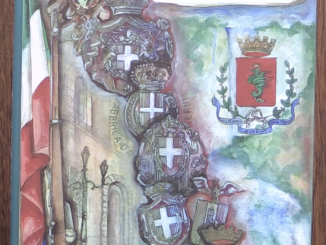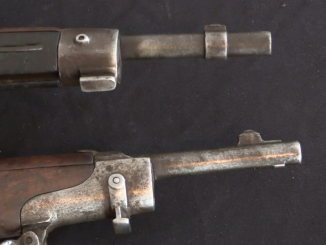Before Samuel Colt popularized the mechanical connection between the revolver hammer and cylinder, the revolvers being made were manually operated. This example is a copy of a third type Collier (that is to say, a gun made originally for percussion caps). After firing, one pulls the cylinder back against a spring and rotates to the next chamber. A shield at the front of the cylinder protects the chambers, and the cylinder mouth is chamfered to seal into the barrel, preventing most of the gas leakage at the cylinder gap. This beautiful ornate example was made by Salvatore Mazza of Naples (the official armorer of the Prince of Sicily, he would like you to know!), most likely in the 1820s.
Related Articles

Book review
Book Review: La Régia Fabbrica d’Armi di Terni
This is no ordinary firearms reference book. This is a 900-page, nearly 12 pound tome in Italian. And not justify Italian; hand-written cursive Italian. With a substantial number of hand-painted illustrations. It is about the […]

Semiauto Rifles
Breda PG Photos
We recently had the opportunity to handle a Breda PG rifle. They were made in 1935 in Italy, and the only major sale made was to the government of Cost Rica (in 7mm Mauser). The […]

Bolt Action Rifles
Special Troops M91 Carcano Carbine and the M91/24 Carbine
“Special Troops” does not mean Special Forces; it means all the various service branches that need neither a full length rifle nor a permanently attached bayonet. This included artillery, engineers, naval troops, and more. The […]

The ramrod seems just a little shorter than I would expect for seating the bullet within the chamber.
I thought the same thing. It appears the rod would only get the ball down to the end of the barrel. That would be a good reason for the enhanced chamber seal if the cylinders only hold the powder charge.
Ironically, this allows a higher hold relative to the bore axis than the “advanced” MTR-8.
Ian said in his earlier Collier video, “The hammer is cocked which means I can pull the cylinder back and rotate it.”
Strongarm added, “Falling hammer should activate a block for the cylinder not to move backward during firing.”
“Certainly he [Collier] was aware of the problem with the barrel-to-cylinder gap, because he engineered a system that reminds us of the later Nagant revolver. He managed to seal off the rear end of the barrel where it joined the cylinder and therefore didn’t have that ring of fire when he capped one off.” Collier & Colt: The Origins of the Revolver, by Wiley Clapp, 9/26/20 American Rifleman.
Maybe the stiff cocking force is because there is a cylinder locking mechanism that engages as the hammer drops.
Korean subtitles???
That plate in front of the cylinder is likely to keep the firing cylinder from flashing over to the others.